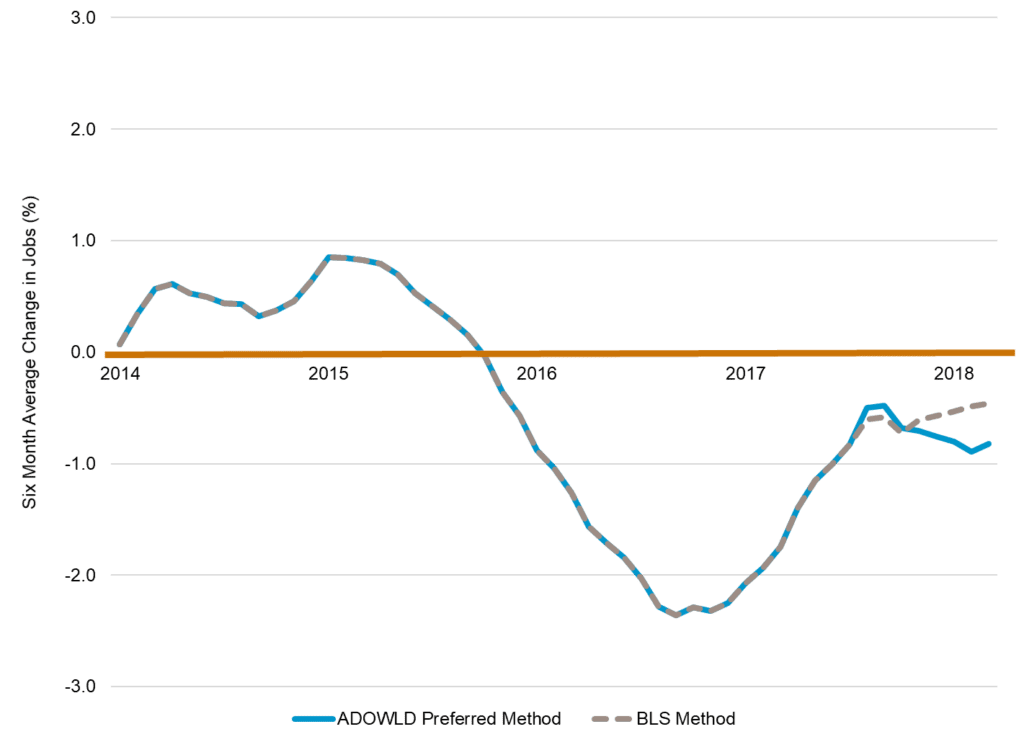

So where are we with respect to jobs? Well, you may remember this figure from my December blog which showed that based on 
It’s at this point that I eat a substantial serving of crow (or perhaps Magpie given the lack of crows here in Anchorage). Not only did ADOLWD revise many of their monthly estimates for 2017 downward, but now we have a new time-series. Ahh, live by the data, die by the data. Our new figure using six-month average Year-Over-Year (YOY) employment data is below. Remember, above the solid orange line is growth and below it is a jobs recession. We see the same plunge into recession starting in the fourth quarter of 2015 and the same start of a U-shaped slow down of the recession/recovery from 2016 through 2017, but somewhere around late 2017 things went awry and our trek toward recovery stalled out. Both the original series reported to BLS (dashed grey line) and the new ADOWLD-preferred series (blue line) show we are still pattern of shedding jobs; albeit at a much, much slower rate than 18-months ago. The indicators currently suggest we’re losing 0.5 percent to 0.8 percent of our wage and salary jobs per year. In addition, the ADOWLD series is showing a double-dip pattern where conditions improved and then deteriorated.
Figure 1. Halcyon Consulting Growth-Recession Indicator, June 2018
So, what’s going on within the economy? Oil prices have bounced back to $70+ per barrel and oil industry spending is stabilizing; I even heard a major oil field services advertising for local workers on the radio last week. State spending has stabilized and will grow slightly with this year’s budget. We just completed two quarters of YOY wage growth for the first time since 2015. The general feeling of businesses seems to be one of stabilization, albeit at a lower level of activity than in pre-recession Alaska and my May blog post showed that the rate of change in Medicaid enrollments has slowed to pre-recessionary levels. Heck, monthly unemployment insurance payments hit a modern record low this winter. ADOLWD has a great discussion here on why the role of UI payments in the economy might be changing.
While we see signs of improvement elsewhere, we’re still stuck in a jobs recession. Total wage and salary jobs are falling even as other parts of the economic picture (i.e., sentiment, wages, GDP, public assistance claims, major sector spending) are all stabilizing or improving. How can we have this disconnect? First, many of our current losses are low-wage jobs in the retail sector. Local retail has been hit by both the recession and the “Amazon effect.” Thus, broader changes in the American economy may be contributing to current losses. Second, for the non-retail jobs, I think our population demographics, shrinking population, and shrinking labor force play a role.
- Our labor force is falling as boomers retire and we have an extended period of net out-migration; ADOLWD data show the labor force and total population are smaller than they used to be. This dual loss in the labor force and population can leave proportionally more jobs for everyone else while leaving fewer unemployed around. Think of a game of musical chairs where we kick people out of the game faster than we remove chairs; for a while you don’t really notice the loss in chairs because there’s a seat for those remaining.
- We know that more boomers are retiring and that when someone retires they transition to saved assets to replace their employment income. If someone retires here in Alaska, and the employer doesn’t fill the position, it’s a loss of a job in the numbers, but consumer spending can stay about the same because of the transition to those retirement assets. We have a lot of boomers retiring right now as that demographic hits its peak transitional age. Many of them are choosing to stay and their spending is helping prop up the economy.
Is it possible for an economy to continually lose a low level of jobs and be healthy? In the short run, it’s possible for the broader economic decline to not be very noticeable especially when losses are largely confined to low-wage sectors (as they are now). In the long-run these losses take their toll upon asset prices (e.g., housing), the to ability maintain infrastructure, and the ability to recruit and retain talented workers. So, the questions for Alaska are as they have been for some time- When do we find economic stability? How do we return to growth?
Jonathan’s Takeaway: The employment data show a stubborn jobs recession is still hanging with us, but that losses have slowed and largely transitioned to lower wage sectors of the economy. Without the stimulus of an increasing population or increased spending from our most important sectors, wage and salary jobs will continue to hover in this no man’s land of slow losses to limited growth. Jonathan wants to thank ADOLWD’s Research and Analysis and Administrative Services Division for their assistance with acquiring data and willingness to be a sounding board. Our ADOLWD researchers and economists are some of the best in the country.
Jonathan King is a consulting economist and Certified Professional Coach. His firm, Halcyon Consulting, is dedicated to helping clients reach their goals through accountability, integrity, and personal growth. Jonathan has 21 years of social science consulting experience including 15 years in Alaska. The comments in this blog do not necessarily represent the view of employers and clients past or present and are Jonathan’s alone. Suggested blog topics, constructive feedback, and comments are desired at askjonathan@apcm.net.
7/18/18
[1] The two series only exist for the most recent months of data. When the ADOWLD finalizes their monthly numbers using the Quarterly Census of Employment and Wages, the two series become one finalized estimate.
7/18/18







